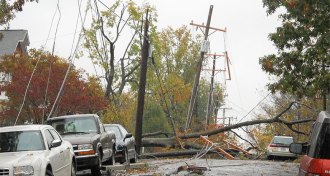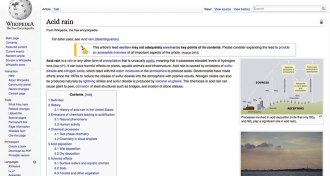Science Stats
-
 Health & Medicine
Health & MedicineHaving sex doesn’t trigger heart attacks, study suggests
Sex doesn’t trigger heart attacks, study of patients with cardiovascular disease suggests.
By Meghan Rosen -
 Climate
ClimateHurricane reports ignore indirect deaths
Nearly half of all hurricane and tropical storm fatalities are indirect, yet they typically aren’t included in official storm reports.
-
 Science & Society
Science & SocietyContentious science topics on Wikipedia subject to editing mischief
Global warming and other politically charged issues are prime targets for sabotage on Wikipedia.
By Meghan Rosen -
 Climate
ClimateCarbon cuts could save U.S. farmers billions of dollars
Reducing carbon emissions could save U.S. agriculture industry billions of dollars annually by curtailing droughts.
-
 Health & Medicine
Health & MedicineFootball games come with more head hits than practices do
As football intensifies from practice to games, the number of impacts increases, a new study finds.
-
 Animals
AnimalsSimple change to fishing nets could save endangered whales’ lives
Making industrial fishing ropes weaker would reduce humpback and right whale bycatch by almost three-quarters
-
 Climate
ClimateIceless Arctic summers now expected by 2050s
The Arctic Ocean will have its first ice-free summer in the 2050s, nine years earlier than previously forecast, according to improved simulations.
-
 Environment
EnvironmentFracking doesn’t always go to great depths
Fracking at shallow depths is unexpectedly common in the United States and raises new concern for drinking water contamination.
By Beth Mole -
 Health & Medicine
Health & MedicineBystanders deliver on CPR
People suffering from cardiac arrest are more likely to survive without brain damage if a bystander performs CPR, new studies suggest.
By Nathan Seppa -
 Climate
ClimateWildfire seasons have gotten almost 20 percent longer
The average length of wildfire seasons has increased 18.7 percent since 1979, new research shows.
-
 Animals
AnimalsGiant pandas live in the slow lane
Giant pandas burn far less energy than similarly sized land mammals.
By Meghan Rosen -
 Earth
EarthMost of Earth’s impact craters await discovery
Hundreds of undiscovered impact craters probably dot Earth’s surface, new research estimates.